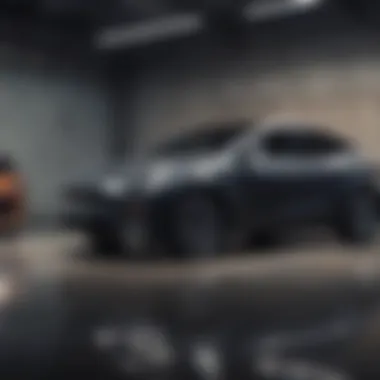Tesla Model Y: Exploring the Future of Three-Row Seating


Intro
In recent years, the automotive landscape has shifted dramatically towards electric vehicles, with the Tesla Model Y leading this transformation. As consumers increasingly favor larger electric SUVs, the prospect of a three-row seating configuration becomes a compelling consideration for both manufacturers and buyers. The Model Y's spacious architecture positions it to accommodate additional seating, but this adaptation raises vital questions about its design and performance.
This article aims to delve into various aspects of the Tesla Model Y by exploring its potential for three-row seating. We will discuss the growing consumer interest in larger electric SUVs, the modifications necessary for expanded capacity, and how these changes may affect the vehicle's performance and battery range. Furthermore, we will analyze competing models, the practicality of additional seating, safety issues, and projections for the future of electric vehicles. The insights provided here will serve to inform automotive enthusiasts and prospective buyers alike, as they navigate this evolving segment of the market.
Car Reviews
Overview of the Vehicle
The Tesla Model Y is an all-electric compact SUV that emphasizes efficiency and practicality. With its sleek design and advanced technology, it appeals to a diverse audience. The possibility of introducing three-row seating could enhance its appeal, allowing it to cater to families and larger groups. However, this transition requires careful evaluation of space and layout, ensuring passenger comfort without compromising cargo capacity.
Performance Analysis
One of the crucial aspects to consider with any vehicle modification is how it affects performance. The Model Y currently offers impressive acceleration and handling due to its low center of gravity. Integrating a three-row option may impact these performance factors, particularly weight distribution and battery use. Therefore, it's essential to study how the introduction of more seating will influence its driving dynamics and efficiency.
Design and Interior Features
The interior of the Model Y is designed with minimalism in mind, featuring a large touchscreen that controls most of the vehicle's functions. If three-row seating is to become a reality, significant design adaptations are necessary. This includes reconfiguring the rear area to accommodate an additional row while maintaining the upscale environment Tesla is known for. Furthermore, considerations for passenger accessibility and legroom must be addressed.
Safety Ratings and Specifications
Safety is paramount in any vehicle, and a three-row Model Y must uphold Tesla's high standards. Currently, the Model Y has received excellent safety ratings. Introducing additional rows could alter these ratings, making it crucial to conduct thorough safety testing. Examining crash test results and safety features specific to this configuration will be pivotal for consumer confidence.
Value for Money
The question of whether adding three-row seating is a good value proposition for the Model Y is complex. While it could attract a broader market segment, it's important to assess how it affects the price point and overall value. Consumers often consider both initial cost and long-term savings. Analyzing competitors who offer three-row electric SUVs may provide valuable insights into the pricing strategy Tesla might adopt.
Automotive Industry Trends
Emerging Technologies
As the electric vehicle sector evolves, technological advancements play a central role. Innovations such as improved battery technology and autonomous driving features are rapidly changing the landscape. For the Model Y to integrate three-row seating effectively, it must leverage these technologies, ensuring optimal performance and sustainability.
Changes in Consumer Preferences
Consumer demand has shifted dramatically towards larger vehicles, including SUVs. Families often prefer vehicles with more space for comfort and convenience. The potential for three-row seating aligns with these preferences, catering to households looking for electric alternatives.
Sustainability and Eco-Friendly Practices
The pursuit of sustainability remains a core principle of Tesla. Adding three-row seating must not undermine its commitment to eco-friendly manufacturing and operational practices. Balancing consumer needs with environmental responsibility is key to maintaining brand integrity.
Future of Electric Vehicles
The future of the electric vehicle market appears promising, with increasing adoption and advances in technologies. The Model Y's potential transition to accommodate three-row seating could position it as a leader in this segment, especially with the anticipated growth in family-oriented electric vehicles.
Industry Challenges and Solutions
Despite the optimistic outlook, challenges such as infrastructure development and market competition remain. Addressing these challenges through strategic planning and innovation will determine the success of the Model Y’s potential three-row adaptation.
"The evolution of electric SUV options is crucial in meeting the diverse needs of consumers nationwide."
Closure
As we explore the possibilities of three-row seating in the Tesla Model Y, it is clear that several factors contribute to this consideration. From performance impacts to design and safety ratings, each aspect necessitates thorough examination. This exploration serves to equip consumers with insights needed in this competitive electric vehicle market.
Preamble to Tesla's Model Y
Tesla has emerged as a profound player in the electric vehicle landscape. The Model Y is part of that narrative, encapsulating the company’s forward-thinking ethos. Understanding the Model Y is essential, especially with discussions about its potential three-row seating capabilities. This section provides an overview of what makes the Model Y significant in the broader context of electric vehicles and consumer choice.
Overview of Tesla's Electric Vehicle Strategy
Tesla's strategy for electric vehicles involves constant innovation and aiming for efficiency. With a focus on sustainability, Tesla combines performance with eco-friendliness. It has carved a niche by providing high-performance vehicles that also contribute to reducing carbon emissions. The Model Y fits into this strategy as a compact SUV that not only appeals to environmental concerns but meets customer expectations for utility and versatility.
Key aspects of Tesla’s strategy include:
- Scalability: The flexibility in design allows customers to choose between different configurations, enhancing user experience.
- Supercharger Network: Access to Tesla’s extensive charging infrastructure mitigates concerns around range anxiety.
- Software Updates: Vehicles improve over time through over-the-air updates, keeping the technology relevant without requiring new hardware.


Significance of the SUV Market
The shift in consumer preferences toward SUVs is noticeable. The SUV segment has been steadily growing and attracting diverse buyers. SUV buyers often prioritize space, comfort, and versatility. The rise of electric SUVs, including the Model Y, reflects this trend. A three-row option could bolster Tesla’s presence in this rapidly expanding market.
Factors that add to the importance of SUVs include:
- Space and Comfort: Families favor SUVs for their spacious interiors and enhanced comfort during commutes and long trips.
- Versatility: The ability to transport goods and a larger number of passengers is appealing for many buyers.
- Enhanced Visibility: Drivers generally prefer the elevated driving position that SUVs provide.
As the automotive industry progresses, Tesla's Model Y is at the intersection of innovation and consumer demand. The exploration of its capabilities, including potential three-row seating, aligns with evolving market needs. Understanding these dynamics is crucial for anyone interested in the future of electric vehicles.
Current Model Y Features
The features of Tesla's Model Y play a crucial role in understanding the vehicle's market appeal, particularly when considering the prospect of three-row seating. As electric SUVs gain traction, the Model Y's features must demonstrate how they meet both current trends and future possibilities. A well-designed vehicle can enhance the ownership experience and satisfy various consumer needs.
Interior Layout and Design
The interior layout of the Tesla Model Y is vital for functionality and comfort. With a minimalist design, the interior aims to maximize space. Standard five-seat configurations allow for ample legroom, which could be pivotal in a future three-row model.
Design elements, such as the absence of traditional buttons, promote a clean aesthetic, complemented by an impressive panoramic glass roof that gives an open feel to the cabin. However, the challenge lies in accommodating an additional row of seats without compromising aesthetics and existing comfort. Considering the vertical space in the cabin becomes essential when exploring three-row variants.
Technology Integration
Tesla's integration of technology in the Model Y is a significant factor for potential buyers. The central touchscreen serves as the command center, controlling navigation, media, and climate settings. The seamless connectivity with smartphones enhances user experience, catering well to tech-savvy consumers.
If three-row seating is realized, the technology aspects must extend to all passengers. Ensuring that rear-seat passengers can enjoy similar features could include individual screens or connectivity options. This approach may elevate the overall perception of the Model Y as not only a vehicle but also a mobile entertainment platform.
Performance Metrics
Performance metrics are crucial to the appeal of any electric SUV, including the Tesla Model Y. The vehicle is engineered for acceleration and range, with some versions achieving 0-60 mph in as little as 3.5 seconds. Despite the addition of a third row, Tesla must ensure that overall performance is not hindered.
One key factor is the vehicle's battery range. With an estimated range of up to 330 miles, it is essential to maintain efficient performance with added weight from extra seating. The Model Y's dual motor all-wheel drive enhances stability and handling. These metrics underscore the relationship between seating capacity and performance—optimizing both aspects can lead to a robust offering in the crowded electric SUV market.
"Tesla's approach to performance is as critical as its commitment to electric innovation."
Overall, the current features of the Model Y indicate how well it's poised for consumer needs, especially as electric SUVs evolve. By focusing on interior design, technological advancements, and performance metrics, the Model Y can adapt to meet the demand for three-row configurations.
Consumer Demand for Three-Row Seating
The consumer demand for three-row seating in SUVs has been growing due to various factors. This trend reflects a shift in the preferences of families, adventurers, and urban dwellers. A three-row arrangement provides not just additional passenger space but also enhanced versatility for carrying cargo and other essential items.
The demand stems from a practical need for larger vehicles that can accommodate more people. Families with children benefit from the extra seating, allowing them to transport not only family members but also friends and relatives with ease. Additionally, a three-row SUV can serve those who engage in outdoor activities, where they might need extra seats for fellow enthusiasts or more space for gear. This practical benefit is complemented by an increasing interest in electric vehicles, as families begin to seek eco-friendlier transportation options.
Moreover, there are social dynamics at play as well. Consumers are influenced by the perceptions of larger vehicles being more prestigious or luxurious than smaller models. The value placed on spaciousness aligns with contemporary lifestyle choices. As urban living spaces shrink, having a vehicle that can accommodate gatherings, outings, and travel without continual planning for passenger or gear logistics becomes more appealing.
Market Trends and Consumer Preferences
Several market trends highlight this growing consumer preference for three-row SUVs. Firstly, the increase in dual-income households has allowed more consumers to afford vehicles with larger seating capacities. In many regions, the desire for comfort during family trips or commutes directly ties into these preferences.
Key trends influencing demand include:
- Increased family size: More families want a vehicle that fits everyone.
- Shift towards electric vehicles: Environmentally conscious consumers prefer spacious yet sustainable options.
- Adventurous lifestyle pursuits: Many buyers engage in travel or outdoor activities, requiring more passenger space.
- Innovations in safety technology: As more safety features become available, parents feel more secure in larger vehicles.
Best Practices in SUV Configuration
Configuring an SUV to incorporate three-row seating is not just about fitting extra seats. It involves a deliberate approach to design and functionality. Manufacturers must consider interior ergonomics, which encompasses both space and the ease of accessing rear seats.
Effective practices include:
- Optimizing space arrangement: Ensure ample legroom in all rows. The middle row should be easy to slide forward for access to the third row.
- Innovative seating solutions: Use foldable or stowable seats that allow versatility based on passenger or cargo needs.
- Safety first: Ensuring the design meets or exceeds safety standards for all seating capacity levels is crucial.
- User-friendly technology: Integrate tech features such as easily accessible controls and entertainment systems for all seats, improving overall passenger enjoyment.
By adhering to these best practices, manufacturers can successfully meet the growing consumer demand and create vehicles that align with both practical needs and lifestyle aspirations.
Possible Design Modifications for Three Rows
Design modifications for the Tesla Model Y are crucial in accommodating three-row seating. The increasing demand for spacious vehicles among consumers translates to a market where larger electric SUVs, such as the Model Y, must adapt to these needs. To secure a competitive edge, Tesla may need to focus on various elements like dimensions, space allocation, and seating integration.
Dimension and Space Allocation Considerations
The dimensions of an SUV play a vital role in its overall comfort and usability. For the Model Y to successfully adapt to three-row seating, it must prioritize interior space. Key aspects to consider include:


- Overall Length and Wheelbase: Extending the wheelbase would provide additional legroom for passengers in the third row. Longer wheelbases generally improve driving stability as well.
- Height and Width: Adequate roof height allows for a comfortable environment, reducing the feeling of confinement for those in the back rows. Wider dimensions can also enhance overall comfort by allowing more shoulder room for passengers.
- Cargo Space Allocation: Modifications must ensure that cargo space remains adequate after accommodating a third row. Proper configuration is essential to prevent sacrificing practicality for passenger capacity.
By addressing these dimensions, Tesla can enhance the Model Y's appeal to families and those requiring more seating. A balance exists between aesthetics and functionality.
Integration of Additional Seating
The integration of additional seating in the Model Y necessitates thoughtful engineering and innovation. Basic aspects include:
- Seat Design: New seating layouts should prioritize ergonomics, ensuring comfort and support for all passengers, including those in the rear. The choice of materials will directly impact both durability and comfort.
- Access to the Third Row: Easy access is essential. Features like sliding second-row seats can allow a more seamless entry to the third row, ensuring that inconvenience does not deter potential buyers.
- Safety and Stability: Introducing additional seating should not compromise safety features. The structural integrity of the vehicle must be preserved. This may involve reinforcing the chassis or adjusting weight distribution to maintain driving stability.
Through these integrations, Tesla can ensure that the Model Y remains competitive in the growing electric SUV market.
The successful incorporation of three-row seating could redefine the perception of the Model Y, positioning it as a leading choice for families seeking electric options.
Impact on Performance
The integration of three-row seating in the Tesla Model Y significantly impacts its performance metrics. Performance encompasses elements such as battery range, weight distribution, and driving dynamics. Each of these aspects requires careful consideration when designing an SUV that aims to accommodate more passengers while maintaining efficiency. Understanding how these factors interact helps guide potential buyers in their decision-making process.
Battery Range and Efficiency
Battery range is a critical factor for any electric vehicle, especially for consumers who travel long distances. The Tesla Model Y is known for its impressive electric range; however, adding a third row of seating may affect this.
- Weight Addition: By incorporating additional seating, the overall weight of the vehicle increases. Batteries need more energy to propel a heavier vehicle, which could reduce the efficiency and the maximized range.
- Aerodynamics: The design alterations required to fit three rows might impact the vehicle's aerodynamics. If the car becomes less streamlined, it could face increased drag, further affecting energy efficiency.
- Battery Capacity: Tesla can potentially adjust the battery pack configuration. A larger capacity battery may offset some efficiency losses but also adds to weight and costs.
It is essential to monitor how these factors come together in practical scenarios. Future testing and consumer feedback will provide insight into the trade-offs between passenger capacity and range.
Driving Dynamics with Extra Weight
The dynamics of driving are another pivotal concern when discussing three-row seating in Tesla's Model Y. The additional weight influences several driving characteristics, including:
- Handling: As more weight is added to the SUV, changes in handling could become apparent. Drivers may experience altered steering response or swaying during turns.
- Braking Performance: More mass requires greater braking force to halt. Tesla may need to consider upgrades to the braking system to maintain safe stopping distances.
- Suspension Tuning: Adjustments to the suspension will likely be necessary to maintain comfort and stability. A vehicle with a higher weight load may require stiffer springs or enhanced shock absorbers to manage road imperfections effectively.
In essence, the integration of three-row seating will demand a balance between added capacity and the core performance qualities that Tesla drivers have come to appreciate.
The performance dynamics of a three-row Tesla Model Y exemplify the challenges manufacturers face in evolving their designs while enhancing functionality. Understanding these elements will aid consumers in visualizing how the vehicle might perform under varied conditions.
Safety Considerations
Safety is a critical aspect when discussing the Tesla Model Y, particularly in the context of potential three-row seating. As the demand for larger electric SUVs rises, ensuring the well-being of all passengers becomes paramount. A focus on safety features can not only safeguard occupants but also enhance the overall appeal of the vehicle. Thus, understanding the safety considerations for the Model Y is essential for consumers and manufacturers alike.
Crash Test Ratings and Safety Features
The Tesla Model Y has undergone rigorous crash testing to ensure high safety standards. Rated highly by the National Highway Traffic Safety Administration (NHTSA), the vehicle performs well in frontal, side, and rollover tests. These ratings provide valuable insights into the structural integrity and safety of the car.
Key features enhancing the Model Y’s safety include:
- Advanced Airbag System: The Model Y is equipped with multiple airbags that deploy in various crash scenarios, minimizing the risk of injury to passengers.
- Active Safety Technologies: Features such as Automatic Emergency Braking and Lane Departure Avoidance enhance driver awareness and help avoid accidents before they occur.
- Rigid Safety Cell: The design of the vehicle includes a high-strength architecture that envelops passengers, providing added protection during collisions.
Additionally, Tesla’s focus on safety extends to passenger protection in the third row, which is paramount as adding more seats can sometimes compromise safety performance.
Safety Technology Integration for Larger SUVs
The integration of safety technology is crucial when considering the addition of a third row in the Model Y. Larger SUVs present unique challenges regarding visibility and dynamics. Therefore, incorporating advanced safety technologies is vital to maintain a high level of security.
Some important safety technologies for larger SUVs include:
- Surround-View Cameras: Providing a 360-degree view of the vehicle's surroundings, these cameras help drivers navigate safer in tight spaces, crucial for multi-row vehicles.
- Blind Spot Monitoring: This system alerts drivers to vehicles in their blind spots, reducing the risk of accidents during lane changes or merging.
- Adaptive Cruise Control: Utilizing advanced radar and camera systems, Tesla’s adaptive cruise control can adjust speed based on surrounding traffic, enhancing both convenience and safety.
By integrating these safety technologies thoughtfully, the Model Y can maintain its reputation as a safe vehicle even as it expands to accommodate more passengers. Emphasis on safety will continue to play a key role in consumer decisions as they evaluate the Model Y against competitors in the expanding electric SUV market.
"As Tesla adapts to consumer demand for larger SUVs, maintaining high safety standards will be essential to uphold the brand’s reputation for innovation and reliability."
Comparative Analysis with Competitors
The competitive landscape for electric vehicles is rapidly changing, particularly among SUVs. This section examines how Tesla's Model Y stands against its rivals in the three-row electric SUV segment. Understanding this comparative analysis is crucial for prospective buyers who seek to determine the value, features, and overall performance that different models might offer.
Identifying which models lead the market can provide insights into what consumers prioritize when choosing a vehicle. This analysis incorporates several key elements including price, technology, space, and performance metrics. It also highlights notable benefits of the Model Y in comparison to its rivals. For many buyers, features such as battery range, charging speed, and overall usability are essential factors.
Leading Three-Row Electric SUVs


The demand for three-row electric SUVs has grown significantly. Several manufacturers have introduced or are planning to launch offerings that compete with Tesla’s Model Y.
- Ford Mustang Mach-E: Known for its sporty design and solid range, this SUV provides a strong option for buyers who prioritize performance.
- Volkswagen ID.4: It offers spaciousness and a user-friendly interface, making it a popular choice among families.
- Rivian R1S: This is designed with adventure in mind, featuring luxury appointments and off-road capability.
- Chevrolet EQB: As a direct contender in the EV segment, it provides competitive range and features that appeal to traditional SUV buyers.
These models highlight various strengths, but the Model Y still holds significant advantages, particularly regarding software and integration into a larger ecosystem of Tesla products.
Market Positioning of the Model Y
Tesla's Model Y has carved out a notable space in the electric SUV market, making it a frontrunner. The company’s brand loyalty and innovative status set it apart from competitors. The following factors contribute to its market positioning:
- Pricing Strategy: The Model Y is competitively priced when compared to similar models with a strong branding reputation.
- Battery Technology: Tesla’s advancements in battery technology grant it a substantial lead in terms of range and efficiency.
- Charging Infrastructure: Tesla's extensive Supercharger network gives it a competitive edge, as buyers often consider the availability of fast charging when selecting an electric vehicle.
Overall, the Model Y's positioning reflects Tesla’s focus on quality, safety, and sustainability, while addressing the consumer demand for larger electric vehicles. This understanding enables consumers to make informed decisions based on their needs and priorities in the evolving automotive marketplace.
Consumer Insights and Feedback
Understanding consumer insights and feedback is crucial for assessing the Tesla Model Y's adaptation for three-row seating. This section delves into the lived experiences of current owners and potential improvements based on user suggestions, both of which provide valuable information for future developments. By analyzing these aspects, we can better understand how well the Model Y is meeting the needs of families and larger groups seeking electric SUVs.
Owner Experiences of the Model Y
Current owners of the Tesla Model Y share a mix of experiences, highlighting both satisfaction and areas for possible enhancement. Most users appreciate the vehicle’s performance, range, and unique technology. The seamless integration of features like Autopilot and the large touchscreen interface stands out as significant benefits for many.
Owners often mention the spaciousness of the cabin as one of the Model Y's strong suits. This is particularly relevant for families, as the open layout provides ample legroom and headspace. However, some users express a desire for more cargo capacity, especially when accommodating additional passengers. A recurring theme in discussions on forums such as Reddit is how three-row seating might affect the balance of comfort and practicality for everyday use.
Feedback on the interior quality is generally positive, though issues like material durability occasionally arise. For those considering the potential addition of a third row, owner experiences suggest that enhancements in accessibility and comfort for rear passengers are critical. Users highlight that any new design should prioritize ease of entry and exit, particularly for children or elderly passengers.
Potential Improvements Suggested by Users
Consumer feedback also points to several specific improvements that could be made to the Model Y if a three-row seating option were to be introduced. Notable suggestions include:
- Enhanced Cabin Features: Many users recommend investing in higher-quality materials for the interior and improving sound insulation to create a more luxurious and quiet ride.
- Improved Seating Configuration: Suggestions often emphasize the need for a flexible seating arrangement. Many users want the option to easily fold down seats for added storage or adjust them for better access to the third row.
- Safety Enhancements: As with any family vehicle, safety is paramount. Consumers expect that additional features like active safety systems and child seat accommodations be integrated effectively in a potential three-row version.
- Battery Efficiency: Owners express concern about maintaining battery range with an additional row of seats. Solutions that provide efficient energy use without compromising performance would be essential in addressing this.
In summary, the insights gathered from Tesla Model Y owners reveal both gratification with the current design and clear expectations for future enhancements, especially if a three-row configuration is realized.
Future Projections for Tesla and Electric SUVs
The electric vehicle market continues to accelerate in both technology and consumer demand. Tesla, as a leader in this segment, shapes many future trends in its approach to electric SUVs, particularly with the Model Y. This part of the article addresses the significance of Tesla's future projections for electric SUVs. Understanding how Tesla aims to grow and adapt gives us insight into how electric vehicles will evolve.
Tesla's Strategic Goals for Growth
Tesla has set ambitious goals to enhance its market presence and production capacity. The company aims to increase its vehicle output significantly, targeting the production of multiple million vehicles annually. This strategy reflects not only an effort to satisfy rising demand but also a commitment to lowering production costs.
To achieve this, Tesla is investing in various aspects of its operations:
- Gigafactories: Building large-scale production facilities worldwide to mass-produce electric vehicles and their components like batteries.
- Innovation in Design and Engineering: Continuously improving the design of their vehicles to enhance performance and user experience, such as optimizing for three-row seating in the Model Y.
- Customer-Centric Approach: Listening to customer feedback and adapting Models accordingly to fulfill consumer needs like family-friendly features.
- Sustainability Focus: Integrating sustainable practices across its supply chain to minimize environmental impact, thus attracting eco-conscious buyers.
These goals reflect Tesla's understanding of the dynamic automotive landscape and its role within it. Staying ahead of the competition will require not only capitalizing on current trends but also anticipating them.
Evolving Technologies in Electric Motors
As electric SUVs become increasingly central to automobile strategies, advancements in motor technology will play a crucial role. Tesla constantly seeks new ways to improve electric motors for enhanced performance and efficiency. This includes:
- Improved Efficiency: By refining electric motor designs, Tesla aims to reduce energy loss, translating to better battery utilization and longer ranges.
- High Performance: Innovations in motor technology can result in more powerful acceleration and smoother driving experiences. Electric motors that can deliver higher torque at lower speeds will enhance the driving experience.
- Sustainability in Manufacturing: Evolving motor technologies may also involve using new materials that reduce the carbon footprint during production, aligning with Tesla's environmental goals.
- Advanced Control Systems: Innovations such as AI-driven systems for optimizing power distribution between motors will help manage energy better.
"Tesla’s commitment to growth and technological evolution will shape the future of electric SUVs, particularly as it adapts products to meet market demands."
By tracking these developments, stakeholders can gain valuable insights into not only Tesla’s trajectory but also the broader electric vehicle landscape.
The End
The conclusion of this article serves as a vital touchpoint in understanding the future of the Tesla Model Y and its adaptation for three-row seating. As the demand for electric SUVs grows, the importance of this adaptation becomes clear. This modification has potential benefits in terms of market reach and consumer satisfaction. The significance of the Model Y’s design lies in its ability to cater to families and those requiring additional space without compromising Tesla's core principles of efficiency and sustainability.
Final Thoughts on the Model Y Adaptation
The Model Y represents an intersection of innovation and practicality. Adapting it for three-row seating can broaden its appeal significantly. Consumers today increasingly prefer vehicles that can accommodate larger families or provide ample space for passengers and cargo. By creating a three-row version, Tesla could position itself to capture a larger segment of the market. User feedback indicates that spaciousness within electric vehicles is a priority. Therefore, ensuring comfort and flexibility in seating arrangements aligns perfectly with consumer demands, creating a compelling case for this design evolution.
The Future of Electric SUVs
The landscape of the automotive industry is increasingly shifting toward electric vehicles. As we look to the future, the evolution of electric SUVs like the Tesla Model Y holds substantial promise. Key trends suggest a growing preference for electric SUVs as more consumers become environmentally conscious.
Factors driving this trend include:
- Technological Advancements: Innovations in battery technology are enhancing range and efficiency.
- Government Regulations: Increased regulations supporting electric vehicle adoption bolster market demand.
- Consumer Trends: The shift in consumer preferences towards sustainability fuels interest.
The future appears bright for electric SUVs. Tesla's strategy to innovate within this segment will likely play a crucial role in shaping transportation in the coming years. Meeting expectations for functionality, safety, and eco-responsibility stands as a priority for consumers. Thus, the Tesla Model Y’s adaptation to accommodate three-row seating enhances its competitiveness and relevance in a rapidly evolving market.





